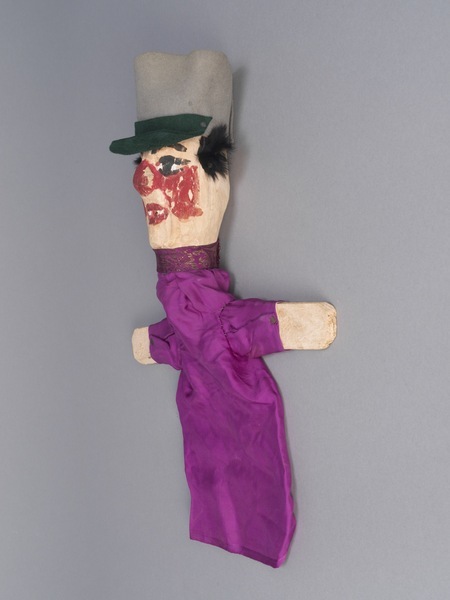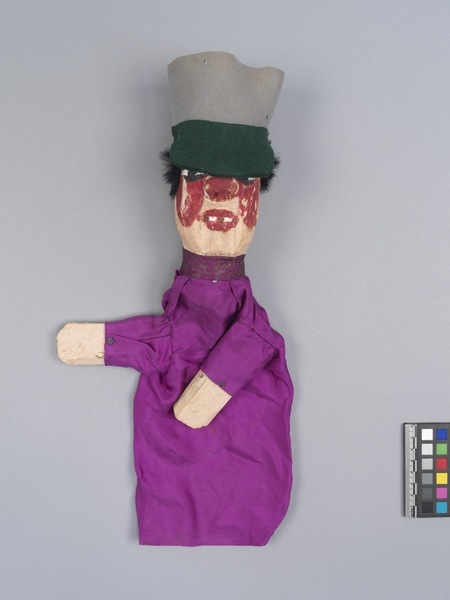Hand Puppet Item Number: 3337/3 from the MOA: University of British Columbia



Description
Hand puppet of character named Gnafron. Head and hands are carved from wood and painted. He has black eyes and eyebrows, a red nose and face, red lips and exposed teeth. He wears a grey and green brim felt hat, open at the top, revealing flat painted wood, and tufts of black hair on the sides and back. His fabric body is bright purple with a dark purple with gold embroidered collar. The fabric is nailed to the hands and head. Operated by inserting a hand inside the body of the puppet to control its head and movements.
History Of Use
Represents the character Gnafron from the Guignol marionnette à main (hand puppet) tradition. An unemployed and impoverished silk-factory worker, Laurent Mourguet, from Lyons, is said to have created the first Guignol hand puppets in the early 1800s to earn money on the city streets to feed his family. The name Guignol belongs to the key character of this French puppetry tradition. With his trademark black cap—worn by lower class factory workers—Guignol is a simple yet kind-hearted fellow, who gets into sticky situations with his cobbler pal, Gnafron—the one with the ruddy face, who drinks too much wine. Other stock characters are: Guignol’s wife, Madelon; the Gendarme (policeman), Flagelot; the Judge, the Cardinal, and the Devil. Performed in pop-up booths, Guignol stories are full of humour, satire, and wit. Using local accents, dialect and slang, the plays and skits spotlight daily events and current affairs, poking fun at politicians, civic leaders and the upper classes. The raucous acts call for audience engagement: response, directions, feigned shock and lots of laughter.
Item History
- Made in Lyon, France before 1940
- Owned by Marcus Sampaio before December 21, 2018
- Received from Marcus Sampaio (Seller) and Museum of Anthropology Exhibitions Budget (Funding source) on December 21, 2018
What
- Name
- Hand Puppet
- Identification Number
- 3337/3
- Type of Item
- puppet
- Material
- silk fibre ?, wood, paint, metal, wool fibre ?, cotton fibre and skin
- Overall
- height 40.0 cm, width 27.0 cm, depth 8.0 cm
Who
- Culture
- French
- Previous Owner
- Marcus Sampaio
- Received from
- Marcus Sampaio (Seller) and Museum of Anthropology Exhibitions Budget (Funding source)
Where
- Holding Institution
- MOA: University of British Columbia
- Made in
- Lyon, France
When
- Creation Date
- before 1940
- Ownership Date
- before December 21, 2018
- Acquisition Date
- on December 21, 2018
Other
- Condition
- fair
- Accession Number
- 3337/0003